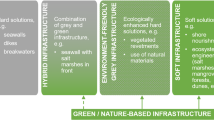Abstract
The problem of designing spatially cohesive nature reserve systems that meet biodiversity objectives is formulated as a nonlinear integer programming problem. The multiobjective function minimises a combination of boundary length, area and failed representation of the biological attributes we are trying to conserve. The task is to reserve a subset of sites that best meet this objective. We use data on the distribution of habitats in the Northern Territory, Australia, to show how simulated annealing and a greedy heuristic algorithm can be used to generate good solutions to such large reserve design problems, and to compare the effectiveness of these methods.
Similar content being viewed by others
References
J.A. McNeely, K.R. Miller, W.V. Reid, R.A. Mittermeier and T.B. Werner, Conserving the World's Biodiversity (IUCN Publication Services, Gland, 1990).
M.E. Soule, Conservation: Tactics for a constant crisis, Science 253 (1991) 744–750.
H. Possingham, I. Ball and S. Andelman, Mathematical methods for identifying representative reserve networks, in: Quantitative Methods for Conservation Biology, eds. S. Ferson and M. Burgman (Springer, New York, 2000) pp. 291–305.
H.P. Possingham, J.R. Day, M. Goldfinch and F. Salzborn, The mathematics of designing a network of protected areas for conservation, in: Decision Sciences: Tools for Today. Proceedings of 12th National ASOR Conference, eds. D.J. Sutton, C.E.M. Pearce and E.A. Cousins (ASOR, Adelaide, 1993) pp. 536–545.
H.A. Taha, Operations Research, An Introduction, 5th Ed. (MacMillan Publishing Company, 1992).
R.L. Pressey, H.P. Possingham and J.R. Day, Effectiveness of alternative heuristic algorithms for identifying indicative minimum requirements for conservation reserves, Biological Conservation 80 (1997) 207–219.
I. Ball, A. Smith, J.R. Day, R.L. Pressey and H.P. Possingham, Comparison of mathematical algorithms for the design of a reserve system for nature conservation: An application of genetic algorithms and simulated annealing, Journal of Environmental Management (1998), in press.
R.L. Pressey, H.P. Possingham and C.R. Margules, Optimality in reserve selection algorithms: When does it matter and how much?, Biological Conservation 76 (1996) 259–267.
W.F. Fagan, R.S. Cantrell and C. Cosner, How habitat edges change species interactions, American Naturalist (1999), in press.
A.O. Nicholls and C.R. Margules, An upgraded reserve selection algorithm, Biological Conservation 64 (1993) 165–169.
I.R. Ball, Mathematical applications for conservation ecology: The dynamics of tree hollows and the design of nature reserves, Ph.D. thesis, The University of Adelaide (2000).
J.L. Cohen, Multiobjective Programming and Planning (Academic Press, 1978).
J. Wright, C. ReVelle and J. Cohen, A multiobjective integer programming model for the land acquisition problem, Regional Science and Urban Economics 13 (1983) 31–53.
K.C. Gilbert, D.D. Holmes and R.E. Rosenthal, A mutliobjective discrete optimization model for land allocation, Management Science 31 (1985) 1509–1522.
M.R. Garey and D.S. Johnson, Computers and Intractability: A Guide to the Theory of NP-Completeness (Freeman, San Fransisco, CA, 1979).
S. Kirkpatrick, C.D. Gelatt, Jr. and M.P. Vecchi, Optimisation by simulated annealing, Science 220 (1983) 671–680.
R.H.J.M. Otten and L.P.P.P. Van Ginneken, The Annealing Algorithm (Kluwer Academic Publishers, 1989).
M. Lundy and A. Mees, Convergence of an annealing algorithm, Mathematical Programming 34 (1986) 111–124.
Author information
Authors and Affiliations
Rights and permissions
About this article
Cite this article
McDonnell, M.D., Possingham, H.P., Ball, I.R. et al. Mathematical Methods for Spatially Cohesive Reserve Design. Environmental Modeling & Assessment 7, 107–114 (2002). https://doi.org/10.1023/A:1015649716111
Issue Date:
DOI: https://doi.org/10.1023/A:1015649716111




